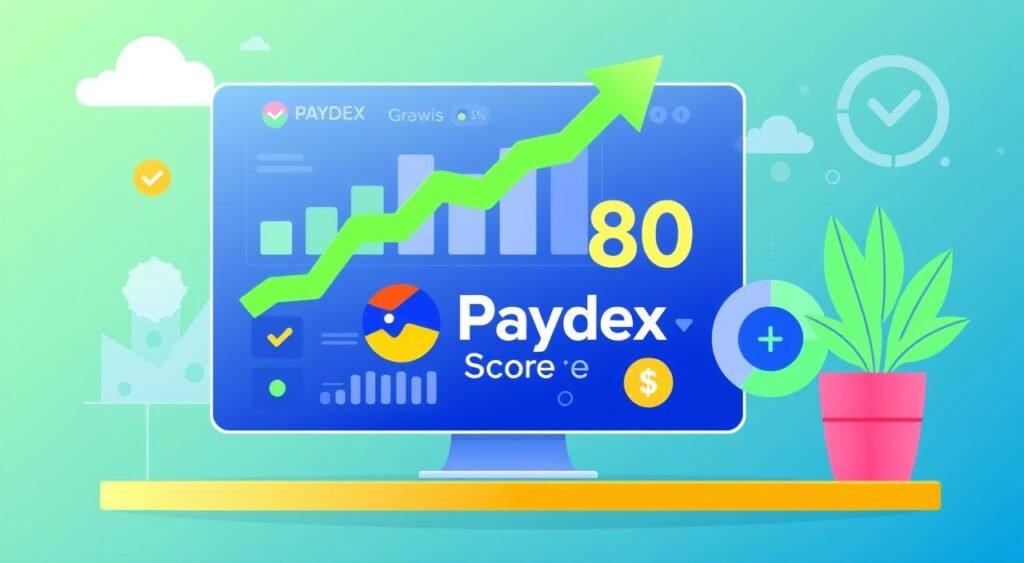Ever wondered how your business’s payment habits shape its financial future? The PAYDEX score, a crucial metric in the world of business credit, holds the key to unlocking better financial opportunities and supplier relationships. This powerful tool, ranging from 0 to 100, offers a snapshot of your company’s payment performance, with higher scores signaling reliability and lower risk to potential partners12.
Understanding and improving your PAYDEX score is vital for small business owners aiming to fuel growth and secure favorable terms. With a score of 80 or above indicating on-time or early payments, businesses can position themselves as trustworthy partners in the eyes of suppliers and lenders alike1.
Ready to boost your creditworthiness rankings and master credit score management? This guide will walk you through proven strategies on how to improve your PAYDEX score, empowering your business to thrive in today’s competitive marketplace.
Key Takeaways
- PAYDEX scores range from 0-100, with 80 being a crucial benchmark
- Timely payments are essential for maintaining a strong PAYDEX score
- A score of 75 or higher indicates low risk to potential partners
- Establishing trade lines and separating personal and business finances are vital steps
- Regular monitoring and proactive credit management can lead to improved scores
- Building strong vendor relationships can positively impact your PAYDEX score
Understanding the PAYDEX Score
The PAYDEX Score is a crucial metric for businesses, offering insights into their payment behavior and creditworthiness. This score plays a vital role in debt repayment strategies and payment history optimization.
What is a PAYDEX Score?
A PAYDEX Score is a unique numerical indicator that reflects how a business pays its bills over the past year. It ranges from 1 to 100, with higher scores indicating better payment practices3. This score is particularly important for business-to-business decisions, influencing creditors, vendors, and lenders in determining a company’s creditworthiness3.
How PAYDEX Scores are calculated
Dun & Bradstreet calculates PAYDEX scores based on the promptness of a business in paying off its debts3. The score is dollar-weighted, meaning that paying off higher debts has a more significant impact3. To establish a PAYDEX score, a business needs to obtain a D-U-N-S number and have at least three reported trade experiences from two or more trade references3.
PAYDEX Score ranges and their significance
PAYDEX scores are categorized into different risk levels:
- 80-100: Low risk, payments made 0-30 days before the due date3
- 50-79: Medium risk, payments made 2-30 days late3
- 0-49: High risk, payments being 31-120 days late3
A score of 80 or higher is generally preferred by most businesses, as it indicates timely or early payments3. This understanding of PAYDEX score ranges can help businesses develop effective debt repayment strategies and focus on payment history optimization.
The Importance of a Strong PAYDEX Score
A robust PAYDEX score plays a vital role in business credit building and showcasing financial responsibility. This score, ranging from 1 to 100, provides lenders and suppliers with a snapshot of your payment history4. Higher scores indicate better payment performance, making your business more attractive to potential partners.
Your PAYDEX score impacts various aspects of your business operations:
- Lease eligibility
- Loan and credit card approvals
- Supplier payment terms
A strong score can lead to increased credit limits and more favorable terms from suppliers and lenders. It’s a key factor in your company’s overall creditworthiness and financial health.
Did you know that D&B uses the PAYDEX score alongside other metrics to determine credit extension recommendations4? This underscores the significance of maintaining a high score for your business’s growth and stability.
“A good PAYDEX score opens doors to better business relationships and financial opportunities.”
Consider these PAYDEX score insights:
| Score Range | Interpretation | Impact |
|---|---|---|
| 80-100 | Low risk | Excellent terms, higher credit limits |
| 50-79 | Medium risk | Average terms, moderate credit limits |
| 0-49 | High risk | Stringent terms, lower credit limits |
Aim for a score of 80 or above to be considered a low-risk business that pays creditors on time5. This level of financial responsibility can significantly enhance your business’s credibility and opportunities for growth.
Establishing Your Business Credit Profile
Building a strong business credit profile is crucial for your company’s financial health. This process involves several key steps that set the foundation for your business’s creditworthiness.
Obtaining a D-U-N-S Number
The first step in establishing your business credit profile is obtaining a D-U-N-S Number from Dun & Bradstreet. This unique identifier is essential for generating a PAYDEX Score, which ranges from 1 to 100, with higher scores indicating a higher likelihood of timely bill payments6.
Separating Personal and Business Finances
Opening a business bank account adds legitimacy to your venture and helps separate personal and business finances6. This separation is crucial for maintaining clear financial records and building a distinct business credit profile.
Opening Business Credit Accounts
Establishing credit with vendors and suppliers can help build your business credit7. Consider applying for a business credit card or corporate card to start building your credit history7. When using business credit cards, keep your credit utilization ratio below 30% to maintain a healthy credit profile6.
Remember, vendor relationship maintenance is key to building a strong credit profile. Making on-time payments with vendors is crucial in maintaining and improving your business credit score7. Regularly check your business credit reports to address any errors or inaccuracies promptly7.
| Credit Building Strategy | Impact on Business Credit |
|---|---|
| Obtain D-U-N-S Number | Essential for PAYDEX Score |
| Separate Business Finances | Builds Business Legitimacy |
| Open Business Credit Accounts | Establishes Credit History |
| Maintain Low Credit Utilization | Improves Credit Score |
| Timely Vendor Payments | Enhances Creditworthiness |
By following these steps and maintaining good financial practices, you can build a strong business credit profile that will benefit your company in the long run.
Timely Payments: The Key to a Higher PAYDEX Score
Timely payment habits are crucial for boosting your PAYDEX score. This score, ranging from 0 to 100, reflects your business’s payment performance, with higher scores indicating better creditworthiness89. To maximize your score’s potential, aim to pay bills before their due dates.

For a PAYDEX score above 80, considered excellent, you typically need to pay bills before invoices are sent8. This level of promptness demonstrates exceptional financial responsibility and can be achieved within 45-90 days of consistent early payments8.
Credit monitoring is essential to track your progress and maintain a high score. Regular checks help ensure your timely payments are accurately reported and reflect positively on your business credit profile.
| PAYDEX Score Range | Risk Level | Payment Behavior |
|---|---|---|
| 80-100 | Low Risk | Excellent payment history |
| 50-79 | Medium Risk | Payments up to 30 days late |
| 1-49 | High Risk | Consistent late payments |
Remember, your PAYDEX score influences crucial business aspects such as lending decisions, vendor relationships, and potential partnerships8. By maintaining strong timely payment habits and actively monitoring your credit, you’re setting your business up for financial success and growth opportunities.
Strategies for Early Bill Payment
Paying bills early is crucial for credit score management. Let’s explore effective strategies to ensure timely payments and boost your PAYDEX score.
Setting up Automatic Payments
Automating your bill payments is a smart move. It helps avoid late fees and ensures consistent, on-time payments. Set up automatic transfers from your business account to pay recurring bills. This method is particularly effective as payment history contributes to 35% of a credit score10.
Negotiating Better Payment Terms
Talk to your suppliers about more favorable payment terms. Some may offer discounts for early payments or extend payment windows. This flexibility can improve your cash flow and help maintain a low credit utilization rate, which makes up 30% of your credit score10.
Utilizing Cash Flow Management Tools
Invest in cash flow management software to forecast potential shortfalls. These tools help you plan for timely payments and avoid cash crunches. By maintaining a credit utilization ratio of 30% or less, you can significantly improve your credit score10.
Remember, implementing these debt repayment strategies can lead to substantial savings. Individuals with excellent credit scores can save hundreds of thousands of dollars over their lifetime10. By focusing on these key areas – payment history (35%), credit utilization (30%), and recent credit applications (10%) – you can effectively manage your FICO® Score11.
Monitoring and Managing Your Business Credit
Credit monitoring is a crucial aspect of maintaining financial responsibility for your business. Regular checks on your business credit report help catch errors or issues that could impact your PAYDEX Score. Business credit scores typically range from 1 to 100, unlike personal credit scores which usually fall between 300 and 85012.
To stay on top of your credit, consider these options:
- D&B’s CreditSignal: Free access to your PAYDEX Score for 14 days12
- Nav and Tillful: Free access to business credit scores with additional tools12
- Paid services: D&B Credit Insights Basic ($39/month), Experian’s various reports ($39.95-$1,495 annually)12

Regularly reviewing your credit reports helps detect errors or potential fraud early. This practice is essential for maintaining good credit ratings, which enable businesses to borrow funds for expansion and negotiate better terms with suppliers13.
| Credit Bureau | Free Option | Paid Option |
|---|---|---|
| Dun & Bradstreet | CreditSignal (14 days) | Credit Insights Basic ($39/month) |
| Experian | N/A | CreditScore Report ($39.95) |
| Equifax | N/A | Comprehensive reports available |
Remember, your PAYDEX Score reflects payment performance. A score of 100 indicates payment within terms, while 80 shows payment 30 days beyond terms14. By actively managing your business credit, you’ll be better positioned to secure loans, open credit accounts, and even bid for government projects14.
Building Strong Vendor Relationships
Strong vendor relationships are crucial for business credit building and vendor relationship maintenance. Effective partnerships with suppliers can significantly impact your PAYDEX Score and overall financial health.
Establishing Trade Lines with Suppliers
Creating trade lines with suppliers who report to Dun & Bradstreet (D&B) is a key step in improving your business credit. Companies like Uline offer quick application processes for net 30 accounts and may report to Experian Commercial and D&B15. Similarly, Quill allows businesses to apply for net 30 accounts after an initial $100 purchase, reporting primarily to D&B15.
Encouraging Vendors to Report Payments
Not all vendors automatically report payment history to credit bureaus. Actively encourage your suppliers to report your timely payments to D&B. This practice contributes positively to your PAYDEX Score and strengthens your credit profile. Businesses benefit from offering Net 30 payment terms, as this structure allows a 30-day grace period before payment is due16.
Maintaining Open Lines of Communication
Clear communication with vendors is essential for strong relationships. During the COVID-19 pandemic, many businesses experienced significant breakdowns in supplier relationships17. To avoid such issues, maintain transparency in credit terms and ensure timely payments. This approach minimizes financial uncertainties in business relationships17.
| Vendor Relationship Strategy | Benefits |
|---|---|
| Timely Payments | Improved PAYDEX Score, Better Negotiation Power |
| Open Communication | Reduced Financial Risks, Stronger Partnerships |
| Diverse Net 30 Vendor Partnerships | Enhanced Procurement Options, Improved Innovation |
By focusing on these strategies, you can build strong vendor relationships that contribute to your business credit building efforts. Remember, good credit management ensures flexibility in payment terms with suppliers and attracts high-quality vendors for collaboration17.
Creditworthiness Rankings: Understanding Your Position
Understanding your business’s creditworthiness ranking is crucial for effective credit score management. Your PAYDEX Score plays a significant role in determining your position in these rankings. Credit ratings express opinions about credit risk, indicating the ability and willingness of an issuer to meet financial obligations in full and on time18.

Credit ratings range from AAA (excellent) to C or D (the lowest), with each level representing a different degree of creditworthiness19. For businesses, a PAYDEX Score of 80-100 suggests low risk, 50-79 indicates moderate risk, and 0-49 represents high risk or subprime status.
To improve your creditworthiness ranking, aim for a PAYDEX Score of at least 80. This score can lead to better terms on loans, insurance, and supplier agreements. Regular assessment of your position is key to enhancing your business’s financial opportunities.
| Rating Agency | Investment Grade | Non-Investment Grade |
|---|---|---|
| S&P Global | BBB and higher | BB+ and lower |
| Moody’s | Baa3 and higher | Ba1 and lower |
| Fitch | BBB and higher | BB+ and lower |
Factors considered in credit ratings include payment history, outstanding debts, cash flows, income, economic outlook, and unique issues affecting debt repayment19. By focusing on these areas, you can work towards improving your creditworthiness ranking and unlocking better financial opportunities for your business.
Addressing Negative Factors Affecting Your PAYDEX Score
Your PAYDEX score plays a crucial role in your business credit profile. This score ranges from 0 to 100, with higher scores indicating lower risk for creditors and lenders20. To maintain a strong score, it’s essential to address negative factors that might be dragging it down.
Disputing Inaccuracies in Your Credit Report
Regularly review your business credit report for errors. If you spot any inaccuracies, dispute them promptly with Dun & Bradstreet. Incorrect information can significantly impact your score, especially considering that PAYDEX is a dollar-weighted measurement20.
Resolving Outstanding Debts and Judgments
Outstanding debts and judgments can severely impact your PAYDEX score. A score below 50 indicates high risk, with payments being made 31 to 120 days after the due date20. Implement effective debt repayment strategies to resolve these issues quickly and improve your score.
Implementing Strategies to Prevent Future Issues
To maintain a high PAYDEX score, focus on consistent, timely payments. A score of 80 or above signals low risk, indicating payments are made within 30 days before the due date2021. Here are some strategies to prevent future issues:
- Set up automatic payments for recurring bills
- Maintain low credit utilization
- Diversify your credit types
- Separate personal and business finances
- Monitor your PAYDEX score regularly
By implementing these credit score management techniques, you can address negative factors and boost your PAYDEX score. Remember, a higher score enhances your company’s credibility and access to better financing options21.
| PAYDEX Score Range | Risk Level | Payment Behavior |
|---|---|---|
| 80-100 | Low Risk | Payments made 30 days before due date |
| 50-79 | Medium Risk | Payments made 2-30 days after due date |
| 0-49 | High Risk | Payments made 31-120 days after due date |
Conclusion
Improving your PAYDEX score is a vital step in boosting your business’s financial health. By focusing on timely payments and building strong vendor relationships, you can enhance your creditworthiness rankings and unlock better financial opportunities. Remember, a higher PAYDEX score can lead to easier loan approvals and lower interest rates, much like how personal credit scores impact individual borrowing22.
Just as Singapore tops country risk rankings with a score of 88.6 out of 100, your goal should be to aim for the highest possible PAYDEX score23. This score, like other credit ratings, helps lenders and investors make informed decisions about your business’s creditworthiness22. Keep in mind that factors such as financial performance metrics, debt-to-equity ratio, and market conditions all play a role in determining your overall credit standing22.
To improve your PAYDEX score, start by setting up automatic payments, negotiating better terms with suppliers, and using cash flow management tools. Regularly monitor your business credit report and address any inaccuracies promptly. With consistent effort and financial responsibility, you can build a strong credit profile that opens doors to better financial opportunities for your company.
FAQ
What is a PAYDEX Score?
How are PAYDEX Scores calculated?
Why is a strong PAYDEX Score important for businesses?
How can I establish a business credit profile?
What is the key to improving my PAYDEX Score?
How can I ensure early bill payments?
How can I monitor my business credit?
How can strong vendor relationships help improve my PAYDEX Score?
What do the PAYDEX Score ranges indicate?
How can I address negative factors affecting my PAYDEX Score?
Source Links
- PAYDEX Score: The Only Ultimate Guide You Need To Read – https://www.forbes.com/advisor/credit-score/paydex-score/
- PAYDEX Score: The Dun & Bradstreet Business Credit Rating – https://www.nav.com/business-credit-scores/dun-bradstreet-paydex/
- Understanding the Paydex Score – https://www.businessinsider.com/personal-finance/credit-score/what-is-paydex-score
- PAYDEX Business Credit Score: See What Yours Means – https://www.creditsuite.com/blog/decoding-the-paydex-business-credit-score/
- What Is a Good Business Credit Score? – https://www.americanexpress.com/en-us/business/trends-and-insights/articles/what-is-a-good-business-credit-score/
- A Comprehensive Guide to Establishing Business Credit – https://www.investopedia.com/establish-business-credit-7972523
- How to Build Business Credit in 10 Simple Steps – https://ramp.com/blog/how-to-establish-build-business-credit
- PAYDEX Score: The Dun & Bradstreet Business Credit Rating – https://ramp.com/blog/what-is-a-paydex-score
- PAYDEX® Business Credit Score Guide – Huddle Business Capital – https://huddlebc.com/blog/paydex-score-guide
- How to Improve Your Credit Score Fast – https://www.investopedia.com/how-to-improve-your-credit-score-4590097
- How to Improve Your Credit Score Fast – https://www.experian.com/blogs/ask-experian/credit-education/improving-credit/improve-credit-score/
- How To Check Your Business Credit Report | Bankrate – https://www.bankrate.com/credit-cards/business/how-to-check-your-business-credit-report/
- The Importance of Business Credit Monitoring: Proactive Strategies for Success | Bluevine – https://www.bluevine.com/blog/importance-business-credit-monitoring
- A Guide to Understanding Business Credit Ratings | Nav – https://www.nav.com/blog/the-ultimate-guide-to-finally-understanding-business-credit-ratings-in-2024-3180233/
- 7 Best Vendors To Help Build Business Credit in 2024 – https://tipalti.com/en-eu/financial-operations-hub/vendors-that-report-business-credit/
- B2B Credit Card Processing: A Powerful Tool, Enhanced by Net 30 Vendors – https://theceocreative.com/b2b-credit-cards-a-powerful-tool-enhanced-by-net-30-vendors/
- How to build strong supplier relationships through smart credit management – https://www.chaserhq.com/blog/how-to-build-strong-supplier-relationships-through-smart-credit-management
- PDF – https://www.spglobal.com/ratings/_division-assets/pdfs/guide_to_credit_rating_essentials_digital.pdf
- Credit Rating: Definition and Importance to Investors – https://www.investopedia.com/terms/c/creditrating.asp
- What Is A Paydex Score? | Bankrate – https://www.bankrate.com/credit-cards/business/what-is-paydex-score/
- How to Get a PAYDEX Score of 80: The Essential Guide – https://www.unitedcapitalsource.com/blog/paydex-score-80/
- 5 Importance of Credit Ratings And Why Its Matter | NTT DATA Payment Services – https://www.nttdatapay.com/blog/importance-of-credit-ratings/
- Credit rating – https://en.wikipedia.org/wiki/Credit_rating

